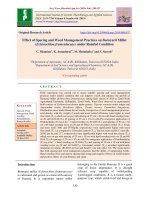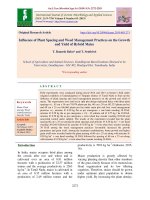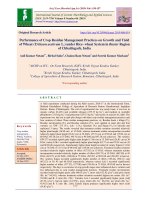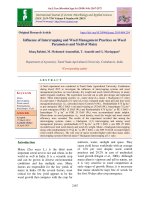Effect of agri-horti systems and weed management practices on growth and yield of finger millet (Eleusine coracana L.)
Bạn đang xem bản rút gọn của tài liệu. Xem và tải ngay bản đầy đủ của tài liệu tại đây (262.95 KB, 10 trang )
Int.J.Curr.Microbiol.App.Sci (2020) 9(7): 1707-1716
International Journal of Current Microbiology and Applied Sciences
ISSN: 2319-7706 Volume 9 Number 7 (2020)
Journal homepage:
Original Research Article
/>
Effect of Agri-horti Systems and Weed Management Practices on Growth
and Yield of Finger Millet (Eleusine coracana L.)
Lokendra Batham1*, Manoj Kumar Singh1, Ashutosh yadav1,
Sudhir Das2 and Sarvesh Kumar3
1
Department of Agronomy, Institute of Agricultural Sciences, Banaras Hindu University,
Varanasi, Uttar Pradesh, India-221005
2
Department of Horticulture, Department of Soil Science, 3Regional Research Sub-Station,
Dr.Rajendra Prasad Central Agricultural University, Pusa, Bihar, India-848125
*Corresponding author
ABSTRACT
Keywords
Agri-horti system,
Finger millet,
Herbicide and weed
management
Article Info
Accepted:
14 June 2020
Available Online:
10 July 2020
Afield experiment was conducted during the kharif (rainy) season of 2018
at Agricultural Research Farm, Banaras Hindu University-South Campusin
Eastern Uttar Pradesh of district Mirzapur in split plot design replicated
thrice. The main factor consist of three agri-horti system i.e. [guava
(Psidium guajava), bael (Aegle marmelos) and open field] while 6-weed
management practices sub factor[2-HW (20 & 40 DAS), Oxyflourfen 0.1
kg a.i./ha (PE) fbclodinafop 60g a.i/ha (PoE), bispyribac-Na 20 g a.i./ha
(early PoE), isoproturon 0.75 kg a.i /ha (PE) fb1-hand-weeding (30 DAS),
pendimethalin 1.0 kg a.i./ha fbquizalofop-ethyl 0.04 kg/ha, 2-HW (20 & 40
DAS) and weedy check]. Application of 2-HW (20 & 40 DAS) and
isoproturon 0.75 kg/ha (PE) fb1- HW (30 DAS) effectively manage the
weeds vis-à-vis produced higher crop growth, yield attributes and yield of
finger millet followed by oxyflourfen 0.1kg/ha (PE) fb clodinafop 60 g/ha
(PoE), bispyribac –Na 20 g/ha (PoE) (15 DAS), pendimethalin 1.0 kg/ha
(PE) fb quizalofop-ethyl 0.04 kg/ha (PoE).
Introduction
Finger millet is an important minor millet that
is cultivated in India. It is a staple food crop
in many of the country's hilly areas. This crop
is grown at an altitude of 2100 meters above
sea level. It is, in reality, the primary cereal
crop for monsoon season in some hill region.
It is cultivated for both grain and forage. In
northern hills, grains are eaten mostly in the
form of, chapattis, in south India grain are
used in many preparations like cakes,
1707
Int.J.Curr.Microbiol.App.Sci (2020) 9(7): 1707-1716
puddings, sweets. Mandua grain contains 9.2
% protein, 1.29 %, 76.32 % carbohydrate,
2.24 % minerals, 3.90 % ash and 0.33 %
calcium. It is good for persons suffering from
diabetes. It is cultivated over an area of 2.65
million hectares with total production of
about 2.9 million tonnes (Singh et al.,
2003).Finger millet is grown largely as drill
sown crop under rainfed conditions and as
transplanted crop under irrigation. Since, the
crop has slow growth habit in the initial
stages, the weeds possessing faster growth
habit can avail of this situation and offer
severe competition to the crop for light,
nutrients and moisture (Kumar et al., 2015)
and (Ramachandra Prasad et al., 1991 and
Singh and Arya, 1999) found the critical
period of weed competition in finger millet to
be around 30 to 45 days after sowing and
further delay in weed control leads to serious
decrease in grain yield ranging from 34 to
61percent.Manual weeding (2-3), common
practices for weed management in finger
millet. Herbicides have been reported to be
effective and economically feasible in the
smallholder (Muoni et al., 2013).
India‟s population is growing rapidly, while
the size of an average farm holding is
shrinking (Srinivasa Rao et al., 2014). Now-adays, it is a biggest challenge for a country to
feed the burgeoning population, that too
without horizontal expansion in land holding.
In fact, in near future, in India the demand of
cereals is projected to grow from current
production of 261.8 million tons (FAO 2019)
to 270 million tons in 2024-2025 (Srinivasa
Rao et al., 2014). Therefore, one of the ways
for increasing the production of cereals is the
utilization of inter-row spaces under
agroforestry system for the introduction of
annual cereals crops. Among the various
categories of agro-forestry system, agri-horti
system is most popular among the farmers,
where the annual crops are grown
simultaneously in the alley of the fruit-tree
(Lundgren and Raintree, 1982; Nair, 1993).
The mechanical and cultural methods of weed
control are no doubt effective; however, nonavailability of labour and ever increasing
labour cost due to rapid urbanization and
industrialization farmers many a time
experience severe labour shortage. Coupled
with ever increasing cost of labour, it is
uneconomical and difficult to employ these
methods to control weeds was reported by
Fischer et al., (2001). The use of herbicides in
controlling weeds has been proved successful
in the advanced countries and is now gaining
ground in Indian Agriculture, in view of
labour scarcity and prohibitive wages. Under
these situations the herbicides play an
important role in weed management.
However, it is essentially required that before
introduction of any crop in between the alleys
of agri-horti system it is utmost important to
work out the compatibility of component
species (annual crop and perennial tree),
because many a time, due to negative
interactions between the component species,
the growth and yield of annual crop was
seriously affected (Thapaliyal et al., 2008).
Agroforestry has the potential to create a
more
integrated,
diverse,
productive,
profitable, healthy, and sustainable land-use
system (Sharma et al., 2017). However, it is
essentially required that before introduction of
any crop in between the alleys of agri-horti
system it is utmost important to work out the
compatibility of component species (annual
crop and perennial tree), because many a
time, due to negative interactions between the
component species, the growth and yield of
annual crop was seriously affected
(Thapaliyal et al., 2008). Since, the crop has
slow growth habit in the initial stages, the
weeds possessing faster growth habit can
avail of this situation and offer severe
competition to the crop for light, nutrients and
moisture (Kumar et al., 2015) and (Prasad et
al., 1991 and Singh and Arya, 1999) found
the critical period of weed competition in
finger millet to be around 30 to 45 days after
1708
Int.J.Curr.Microbiol.App.Sci (2020) 9(7): 1707-1716
sowing and further delay in weed control
leads to serious decrease in grain yield
ranging from 34 to 61 percent. It was
observed that species combinations and
importance of weed communities differ with
agroforestry system because; some studies
have documented inhibitory allelopathic
effects of trees on weed germination and
growth (Kaur et al., 2011). Therefore, one of
the ways for increasing the production of
cereals is the utilization of inter-row spaces
under agroforestry system for the introduction
of annual cereals crops. Among the various
categories of agro-forestry system, agri-horti
system is most popular among the farmers,
where the annual crops are grown
simultaneously in the alley of the fruit-tree
(Lundgren and Raintree 1982, Nair 1993).
This system not only helps in better utilization
of land resources but also generates more
employments and income as compared to sole
cultivation of fruit trees. Actually, during the
initial 6-7 years of agri-horti systems and
even after that period, with proper pruning
management, intercrop annual crops in agrihorti system produce good yield, without any
significantly reduction (Kumar 2018).
Therefore, under the agro-climatic conditions
of Vindhyan zone, there is good opportunity
to introduce some millets as inter-crop in the
alleys of agri-horti system. Millets are the
most viable option in the dryland conditions
as they require minimum water and can with
stand in the adverse weather conditions
(Chapke et al., 2018) and can usher in food,
feed, fodder, nutritional and livelihood
security of the farmers. In fact, millet as also
called as “Miracle Nutri-Cereals” providing
nutritional and health security to all in dry
land ecosystems. Among the various small
millet grown in India, finger millet
contributes nearly 80% of production and the
remaining from kodo millet, little millet,
foxtail millet, barnyard millet and proso millet
in that order (IIMR, 2015).
Materials and Methods
Experimental site and soil
A field experiment was conducted during the
kharif (rainy) season of Agricultural Research
Farm, Banaras Hindu University-South
Campus, 25º 10‟ latitude, 82º 37‟ longitude
and an altitude of 147 meters above mean sea
level, Mirzapur, Uttar Pradesh. The
experimental field soil was sandy clay loam in
texture, classified as Inceptisol (Typic
Ustochrept), having slightly acidic (pH 5.76.4), low in nitrogen and organic carbon
(0.29 %) whereas, medium in available P and
K contents. The total rainfall received during
crop season i.e. august to November growing
period was 455.6 mm, out of which nearly 50
percent receive September.
Trial establishment
In split plot design, experiment was
conducted involving three agri-horticultural
system i.e. guava (Psidium guajava), bael
(Aeglemarmelos) and open field in main plot
and
6-weed
management
practices
[Oxyflourfen 0.1kg a.i./ha (PE)fbclodinafop
60g a.i/ha (PoE), bispyribac-Na 20g a.i./ha
(early PoE), isoproturon0.75 kg a.i /ha (PE)
fb1-hand-weeding (30 DAS), pendimethalin
1.0 kg a.i./ha fbquizalofop-ethyl 0.04 kg /ha,
2-HW (20 & 40 DAS) and weedy check]
were randomly allocated to subplots and
replication three. Seed of finger millet
(variety: VL Mandua 352) was sown at the
rate of 6-8 kg/ha at 10 cm depth in open
furrows made with a manual single row drill,
having a row spacing of 23x10 cm and
immediately covered with soil(Singh et al.,
2003).Crop was uniformly fertilized with
urea, and DAP to supply 40kgN/ha and 40kg
P2O5/ha, respectively. Pre-emergence (PE)
herbicide applied within 2-day of sowing,
whereas, early post emergence (PoE) and PoE
was applied 20 and 30 DAS, respectively.
1709
Int.J.Curr.Microbiol.App.Sci (2020) 9(7): 1707-1716
Before spraying, herbicides were dissolved in
water at the rate of 500 L/ha and sprayed with
a knapsack sprayer fitted with a flat-fan
nozzle.
Biometrical observations
Various yield and straw yield parameters such
grain yield (kg/ha), straw yield (kg/ha),
biological yield, harvest index and total cost
of cultivation, net return and gross return
parameter were recorded. Weed density and
biomass were recorded at 60 DAS, as per the
procedure given by Singh and Saini (2008) as
presented as number/m2 and g/m2,
respectively. For estimation nitrogen (N),
phosphorus (P) and potassium (K) uptake by
green gram and weeds, first N, P, and K
content in plant samples were determined.
Nitrogen content in plant samples (crop and
weeds) were estimated by micro-Kjeldahl
method.
However,
phosphorus
was
estimated
colorimetrically
following
the
vanadomolybdate method and potassium
content in the aliquot of the triple acid extract
was estimated by emission spectrophotometry
using EEL flame photometer (Jackson, 1973).
Statistical analysis
Data collected on crop and weed growth
statistically analysed as per procedure
suggested by Gomez and Gomez, 1984.
Heterogeneous weed (density and biomass)
data were square-root transformed prior to
analysis to produce a near normal distribution,
although non transformed means are
presented for clarity.
The treatment differences were tested by „F‟
test of significance on the basis of null
hypothesis. Critical differences were worked
out at 5 per cent level of probability where „F‟
test was significant.
Results and Discussion
Effect on weed growth
Data presented in table-3 showed that three
agri-hortisystem is similar above the ground
morphology (i.e tree height, canopy diameter,
number of branches, crown length and girth).
Most of the yield and economics parameter are
non-significantly influenced with the agri-horti
system. Further, open field showed lowest
infestation of BLWs. The reasons for increased
growth and yield parameters under open field
might be due to several reasons, firstly, finger
millet being a C4 crop for higher
photosynthetic efficiency requires full sunlight
for light saturation. It is hypothesized that
under the alley cropping system, inter-row
finger millet crop received reduced light due to
shading effect of tress plantation, which would
ultimately reduce the crop yield. Similarly,
Reynolds et al., (2007) also in view that the
degree of light reduction from the agro-forestry
tree species would depend on the tree species,
it‟s shape, height of crown and density of
foliage. Further, they observed that C4 understorey crop produced low yield due to reduced
availability of light. Secondly, under open
field condition due to higher light intensity
there might be more uptake of nutrients due to
enhanced activity of AM fungi, which may
positively affect the various growth and yield
parameters. Similarly, Shukla et al., (2008)
tested the growth response of different crops
u0nder variable light intensity along with AM
inoculation and results showed that the activity
of AM fungi normally enhanced with higher
light intensity (100 per cent) as compared to
the low light intensity, which in turn increase
the P-uptake by the plant. Thirdly, researches
showed that many a time agro-forestry system
exhibited negative allelopathic interactions
which would adversely affect the crop growth
and yield, however, these allelopathic
interactions are absent under the open field
situation (Thapaliyal et al., 2008), thus results
in higher yield.
1710
Int.J.Curr.Microbiol.App.Sci (2020) 9(7): 1707-1716
Table.1 Influences of weed management practices on grain yield, straw yield and economic of finger millet
Treatment
Yield (kg/ha)
Harvest Index
Grain
Straw
Biological
Guava
2901.23b
5056.58a
7957.81b
Bael
2831.33c
3672.84b
Open field
3679.48a
SEm±
CD (P=0.05)
Economics
Total cost of cultivation
(`)
Gross return
(`)
Net return
(`)
B:C ratio
36.48b
48454.43
205564.14
157109.71
4.24
6504.17c
43.40a
48981.82
195609.81
146628.00
3.99
4891.98a
8571.46a
43.60a
22691.77
114924.73
92232.96
5.06
40.44
78.07
118.51
0.67
-
-
-
-
158.79
306.54
465.33
2.65
-
-
-
-
4351.85b
4526.75b
5318.93a
3899.18c
5833.33a
3312.76d
139.62
403.24
S
7453.70c
7833.03c
8840.95b
6701.34d
9619.34a
5618.53e
262.77
758.92
S
41.89a
42.28a
40.04a
41.88a
39.78a
41.09a
1.25
3.62
S
114459.0
112682.7
127232.7
118948.7
136772.7
110672.7
-
512713.52
531298.57
551495.40
485288.62
575769.08
440026.87
-
398254.51
418615.86
424262.69
366340.41
438996.37
329354.16
-
4.48
4.71
4.33
4.08
4.21
3.98
-
Agri-horti system
Weed management practice (W)
3101.85b
Oxy fb Clod
3306.28b
Bis-Na
3522.02a
IPfb 1-HW
2802.16b
PendifbQuiza
3786.01a
2-HW
2305.77c
WC
123.15
SEm±
355.68
CD (P=0.05)
S
S*W
1711
Int.J.Curr.Microbiol.App.Sci (2020) 9(7): 1707-1716
Table.2 Effect of agri-horti system and weed management practices on density and biomass grasses and BLWs in finger millet
Treatment
Agri-horti
system
Guava
Bael
Open field
Acalypha indica
Density
Biomass
(plant/m2 )
(g/m2 )
45 DAS
45 DAS
Oldenlandia corymbosa
Density
Biomass
(plant/m2 )
(g/m2 )
45 DAS
45 DAS
Eclipta alba
Density
Biomass
(plant/m2 )
(g/m2 )
45 DAS
45 DAS
2.68(8.89)a
0.71(0.00)b
1.96(5.28)a
3.89(22.78)a 3.86(22.19)a
0.71(0.00)b 0.71(0.00)b
3.77(22.22)a 3.87(24.16)a
2.46(9.72)b
0.71(0.00)c
3.23(15.28)
a
0.17
0.68
2.96(11.56)a
0.71(0.00)c
1.89(0.07)b
0.27
0.19
SEm±
1.06
0.75
CD (P=0.05)
Weed management practices(w)
1.45(2.78)b 1.61(3.81)b
Oxy fb Clod
2.19(6.67)a
1.78(4.34)b
Bis-Na
1.27(2.22)b
1.28(2.29)c
IPfb 1-HW
2.19(6.11)a
2.29(7.06)b
Pendifb
Quiza
0.71(0.00)b
0.71(0.00)c
2-HW
2.89(10.56)a 3.46(15.73)a
WC
0.40
1.57
0.35
1.37
3.25(18.33)b 3.13(16.74)b
3.19(15.00)b 3.22(15.34)b
1.07(1.67)c 0.97(0.39)c
3.23(15.56)b 3.44(18.69)b
Anagallis arvensis
Density
Biomass
(plant/m2 )
(g/m2 )
45 DAS
45 DAS
2.57(10.57)a
0.71(0.00)b
3.17(15.61)a
3.42(14.72)a
2.99(12.50)b
0.71(0.00))c
4.10(21.89)a
3.52(18.85)b
0.71(0.00)c
0.18
0.70
0.06
0.22
0.08
0.30
1.49(3.89)b 1.61(4.99)b
2.78(11.11)a 3.45(18.04)a
2.46(9.44)b 2.55(10.25)b 2.44(9.44)b
2.83(13.54)b
0.99(1.11)c 1.04(1.25)c
2.40(7.78)b 2.69(10.46)b
3.00(12.78) 3.10(13.67)a 1.77(5.00)b
2.05(7.45)b
b
0.71(0.00)c 0.71(0.00)c
0.71(0.00)c 0.71(0.00)c
0.89(0.56)c
0.78(0.16)c
5.28(39.44)a 5.41(40.93)a
4.15(22.78) 4.08(21.91)a 3.95(20.56)a 4.85(31.83)a
a
0.28
0.32
0.54
0.56
0.36
0.42
0.41
0.50
SEm±
0.81
0.94
1.55
1.62
1.05
1.20
1.19
1.45
CD (P=0.05)
S
S
S
S
S
S
S
S
S*W
Data are subjected to square root transformation, original (non-transformed) values given in parenthesis. Oxy fb Clod =
Oxyflourfen 0.1kg a.i/ha fbclodinafop 60a.i/ha (PoE), Bis-Na =Bispyribac-Na 20 g a.i/ha (PoE) (15DAS),IPfb 1-HW = Isoproturon
0.75 kg a.i/ha (PE) fb1-Hand Weeding (30 DAS), PendifbQuiza = Pendimethalin 1.0 kg a.i/ha fb Q uizalofop-ethyl 0.04 kg/ha (PoE),
2-HW =2-HW (20 & 40 DAS),WC = Weedy check.
1712
Int.J.Curr.Microbiol.App.Sci (2020) 9(7): 1707-1716
Table.3 Biometrical observation of guava and bael plantation
Guava field plantation
Plant Height (m)
At time of
At harvest of
sowing of
finger milletb
a
finger millet
Canopy diameter (m)
At time of
At harvest of
sowing of
finger milletb
a
finger millet
Crown length (m)
At time of sowing
of finger milleta
At harvest of
finger milletb
Girth (m)
At time of
sowing of
finger milleta
At harvest of
finger milletb
Mean
4.31
4.48
4.78
4.95
3.86
3.97
0.35
0.36
Range
3.68 – 4.87
3.75– 4.95
4.26 – 5.48
4.96 – 6.09
3.35 – 5.54
3.48 – 4.39
0.35 – 0.37
0.35– 0.38
0.32
0.34
0.38
0.39
0.28
0.29
0.086
0.086
6.82
7.50
7.72
5.55
5.67
0.55
0.56
6.09 – 7.01
6.24– 7.50
6.78 – 5.58
7.0 – 8.05
4.87 – 6.01
5.02 – 6.24
0.55 – 0.59
0.57 – 0.61
0.21
0.25
0.33
0.36
0.37
0.37
0.03
0.03
SD
Bael field plantation
Mean
6.61
Range
SD
a: Observation recorded on 12.09.2018, b: Observation recorded on 12.11.2018.
1713
Int.J.Curr.Microbiol.App.Sci (2020) 9(7): 1707-1716
Fourthly, as per Burman et al., (2009)and
Anusha et al., (2015) sole crop grown under
open field condition not only have less
competition for light but also for the moisture,
as compared to intercrops in association with
different tree spacing. This might be one of
the prime reasons for reduced yield under
agro-forestry system.
Previous study conducted by Rahangdale et
al., (2014) also recorded higher growth and
yield attributing characters of different crops
like, mungbean, soybean, paddy and till in the
open condition as compared to bamboo based
agrisilviculture system. These results are in
conformity with the findings of Handa et al.,
(1995), Bihari (2001), Shanmughavel and
Francis (2001) and Ahlawat et al., (2008).
Previous experiment conducted in kharif
season under similar location also showed the
higher crop growth and yield attributes of
cowpea in open-field condition as compare to
guava and custard apple-agri-horti system
(Kumar, 2019). Secondly, guava plantation
releases certain allelochemicals in root
rhizosphere which are responsible for
selective inhibition of weed flora under guava
plantations (Kawawa et al., 2016, Chapla and
Campos 2010 and Thapaliyal et al., 2008).
Furthermore, after the open-field condition,
the highest growth, yield attributes and yield
of finger millet was observed under guava
agri-horti system over bael agri-horti system.
Actually, in bael agri-horti system due to
higher canopy diameter and crown length
there was more shading effect on the finger
millet, thus the performance of the crop was
adversely affected (Elizabeth et al., 1990).
On the basis of the investigation, it can now
be concluded that under eastern Uttar
Pradesh, finger millet under guava based agrihorti system showed highest gross return and
net return of combined economics (finger
millet+fruit) as well as followed by bael based
agri-horti system and open field. However,
open field condition recorded the highest
profit (B:C ratio) among the agro-forestry
treatment tested. Moreover, bael based
agrohorti system effectively suppressed the
weeds, particularly critical period of cropweed competition and enhance the yield of
finger millet followed by guava based agrihorti system and open field.
Application of 2-HW (20 & 40 DAS) and
isoproturon 0.75 kg/ha (PE) bf 1- HW (30
DAS) (W3) effectively manage the weeds visà-vis produced higher crop growth, yield
attributes and yield of finger millet. Although,
2-handweeding (45 & 60 DAS) have the
higher weed suppression (WCE 92.91), crop
growth and yield (3786.01kg/ha) of finger
millet, however, under labours scarcity,
application of isoproturon 0.75 kg/ha (PE) bf
1- HW (30 DAS)also gave comparable weed
smothering (WCE 80.56) and enhanced yield
attributes and yield (3522.02 kg/ha) of finger
millet.
References
Ahlawat IPS, and Shivakumar BG, kharif
pulses, In Textbook of field crop
production. Dr. R. Prasad (Ed.). New
Delhi: Indian Council of Agriculture
Research, 2005.
Anusha S, Nagaraju, Mallikarjuna GB,
Bhaskar V, Gururajkombali AND
Vishwanath BR, Performance of finger
millet (Eleusine coracana (L.)Gaertn)
in association with different MPTs in
agroforestry system, Indian Journal of
Agroforestry, 17 (2), 82-85, 2015
Burman D, Gill AS, Baig MJ, And Prasad,
JV, Interaction between Dalbergiasissoo
boundary planting and food- fodder
crop
sequence
under
rainfed
agroecosystem, Indian Journal of
Dryland Agriculture Research and
Development, 24 (1), 67-74 2009.
1714
Int.J.Curr.Microbiol.App.Sci (2020) 9(7): 1707-1716
Chapla TE and Campos JB, Allelopathic
evidence in exotic guava (Psidium
guajavaL.), Brazilian Archives Biology
and Technology, 53 (6), 1359-1362,
2010.
Chapke RR, Prabhakar G, Prasad SIK, Das
VA.
Tonapi,
Improved
millets
production technologies and their
impact, ICAR-Indian Institute of Millets
Research, Hyderabad, India, 2018.
A. Pierson, Richard N, Mack and Black RA,
The effect of shading on photosynthesis,
growth, and regrowth following
defoliation for Bromus tectorum,
Ecologia, 84, 534-543, 1990.
FAO, Crop prospects and food situationquarterly global. Food and Agriculture
Organization of the United Nation
report, 2019.
Gomez KA and Gomez AA, Statistical
Procedures
in
Agriculture
nd
Research, Wiley 2 Edition, New York,
Chichester, 1984.
Handa SS, Chawla AS Sharma, AK, Plants
with
antiinflammatory
activity,
Fitoterapia, 63, 3-31, 1995
IIMR, Annual report-Indian Institute of
Millets Research (IIMR), ISSN-09726608,Hyderabad, India, 2015.
Jackson ML, Soil Chemical Analysis,
Englewood Cliffs, NJ: Prentice –
Hall, 1958.
Kaur S, Singh HP, Batish DR and Kohli RK,
Chemical
characterization
and
allelopathic potential of volatile oil of
Eucalyptus
tereticornis
against
Amaranthus viridis, Journal of Plant
Interactions, 6, 297–302, 2011.
Kawawa RCA, Obiri JF, Muyekho FN,
Omayio DO, Agevi H, Mwaura A,
Obiet L, Kimutai DK, and Sifuna AW,
Allellopathic potential of invasive
Psidium guajava L., Against selected
native tree species in Kakamega
Tropical Forest, Western Kenya,
Journal of Pharmacy and Biological
Sciences,11 ,80-86, 2016.
Kumar PMK, Shekara BG, Sunil CM, and
Yamuna BG, Response of drill sown
finger millet [Eleusine coracana L.] to
pre and post emergence herbicides, An
International Quarterly Journal of Life
Science, 10 (1), 299-302, 2015.
Kumar PMK, Shekara BG, Sunil CM, and
Yamuna BG, Response of drill sown
finger millet [Eleusine coracana L.] to
pre and post emergence herbicides, An
International Quarterly Journal of Life
Science, 10 (1), 299-302, 2015
Lundgren BO and Raintree JB, Sustainable
agroforestry, In: Agricultural Research
for
developmentPotential
and
Challenges in Asia (Nestel B ed.),
International Service for National
Agriculture Research, Den Haag,
Netherlands, 1982.
Muoni T, Rusinamhodzi L, and Thierfelder C,
Weed
control
in
conservation
agriculture systems of Zimbabwe:
Identifying economical best strategies,
Crop Protection, 53, 23- 28, 2013.
Prasad RC, Narasimha TV, Dwarakanath N,
Mune Gowda MK, Krishnamurthy MK
and K, Integrated weed management in
drilled finger millet (Eleusine coracana
L. Gaertn.), Mysore Journal Agriculture
seience, (25), 13-19, 1991.
Rahangdale CP, Pathak NN and Koshta LD,
Impact of bamboo species on growth
and yield attributes of kharif crops
under agroforestry system in wasteland
condition of The Central India,
International Journal of Agroforestry
and Silviculture 1 (3), 31-36 2014.
Radford PJ, Growth analysis formulae their
use and abuse, Crop Science, 7 (3),
171–175, 1967.
Reynolds PE, Simpson JA, Thevathasan NV,
Gordon AM, Effect of tree competition
on corn and soybean photosynthesis,
growth, and yield in a temperate treebased agroforestry intercropping system
1715
Int.J.Curr.Microbiol.App.Sci (2020) 9(7): 1707-1716
in southern Ontario, Canada, Ecological
Engineering, (29), 362-371 2007.
Shukla A, Kumar A, Jha A, Chaturvedi O P,
Prasad R, Gupta A, Effects of shade on
arbuscular mycorrhizal colonization and
growth of crops and tree seedlings in
Central India, Agroforestry Systems,
76, 95–109, 2008.
Shanmughavel P, Francis K, Intercropping
trials of four crops in bamboo
plantations. Journal of Bamboo and
Rattan, 1(1), 3-9, 2001.
Singh HP, Batish DR and Kohli RK,
Allelopathy
interactions
and
allelochemicals: new possibilities for
sustainable weed management, Critical
Reviews of Plant Science, 22, 239-311,
2003.
Singh VC, and Arya MPC, Integrated weed
management in finger millet (Eleusine
coracana),
Indian
Journal
of
Agronomy, 44 (3), 571-575, 1999.
Singh, M.K. and Saini, SS. Planting date,
mulch, and herbicide rate effects on the
growth, yield and physicochemical
properties of menthol mint (Mentha
arvensis L.), Weed Technology, 22,
691–698, 2008.
SrinivasaRao C, and Lal R, Prasad JVNS,
Kodigal AG, Singh R, Jakkula VS,
Sahrawat KL, Venkateswarlu B, Sikka
AK and Virmani SM, Potential and
challenges of rainfed farming in India,
Advances in Agronomy, 115-164.
Thapaliyal S, Bali RS, Singh B andTodaria
NP, Allelopathic effects of tree of
economic importance on germination
and growth of food crops, Journal of
Herbs, Spices & Medicinal Plants,
13(4) 2007.
How to cite this article:
Lokendra Batham, Manoj Kumar Singh, Ashutosh Yadav, Sudhir Das and Sarvesh Kumar.
2020. Effect of Agri-horti Systems and Weed Management Practices on Growth and Yield of
Finger Millet (Eleusine coracana L.). Int.J.Curr.Microbiol.App.Sci. 9(07): 1707-1716.
doi: />
1716









